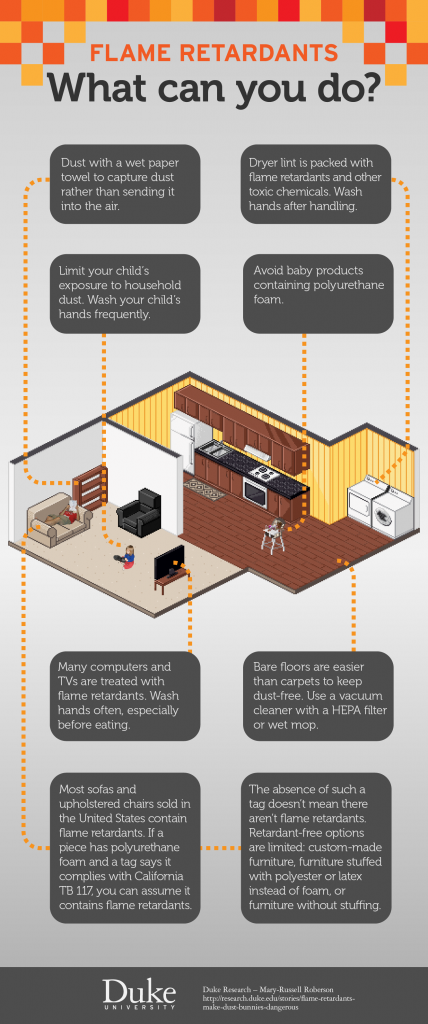At least not when it comes to exposure to toxic chemicals. Unfortunately, many chemicals that are used for a specific purpose (or a by-product of a certain process) in our society are also harmful to human health. Classic examples include chemicals like mercury and PAHs released from burning fossil fuels, as well as pesticides and organic solvents.
But one not so classic example is flame retardants – a topic we’ve been blogging about a lot, particularly this month for October(blog)fest. Flame retardants are somewhat new on the scene and relatively little is understood about their toxicity, in which consumer products they’re used, and what quantities are used in products.
We’ve written about our own research on how flame retarding chemicals may affect the thyroid and impact neurodevelopment, leading to altered behavior and learning ability. You can also read this Duke story about flame retardants and Dr. Heather Stapleton’s research. But toxicity is only important if exposure occurs, so how are people exposed to flame retardants?
Flame retardants are used in many consumer products. The two primary markets are electronics and furniture. Many of the electronics we use in our daily routines (think cell phones, computers, and televisions) have flame retardants to keep the tiny parts conducting electrical currents from bursting into flame while we talk on our phones, look at cat pictures on the internet, or watch the latest episode of Modern Family. Polyurethane foams used in furniture, such as couches and mattresses, are often treated with flame retardants in order to meet specific flammability standards.
There’s very little information out there on how much of certain flame retardants are in foam or electronics. Some groups offer testing of household products so consumers are aware of concentrations of chemicals. And some companies, including the electronics world, are making moves away from certain chemicals including flame retardants, BPA, and phthalates. But somehow, flame retardants are escaping electronics and furniture and ending up in our bodies and, oddly enough, some food.
Multiple peer-reviewed studies have found concentrations of flame retardants in blood samples (Herbstman et al and Marchitti et al) and breast milk (Gascon et al and the Marchitti paper). Several of the studies found high levels of flame retardants in both blood and breast milk – the concentrations in breast milk are concerning since nursing infants and toddlers are likely to be directly exposed to flame retardants during critical periods of development. It’s unlikely that people are eating the foam in their furniture or crunching on their electronics, so how are the flame retardants getting in?

(click the image to view a larger version)
Diet is one likely route. Numerous studies in the US (Schecter et al)and Fraser et al), Spain (Bocio et al), and Japan (Ohta et al) have looked at PBDEs (a type of brominated flame retardant) and dietary routes of exposure with a focus on fish, poultry, red meat, and dairy consumption. One of the key findings was that meat and dairy products tend to have pretty high concentrations of flame retardants while vegetables have much lower concentrations. Related to this, women who ate a lot of meat and dairy products were often more likely to have higher concentrations of flame retardants in their breast milk. The focus on meat and dairy is likely due to the fact that flame retardants are lipophilic, meaning they dissolve in fats and not in water. Thus, they’re more likely to be found in things with a high fat content. One study even found that vegetarians had serum PBDE concentrations 25% lower than those of omnivores.
The other likely route is dust. Again, a lot of studies have been conducted looking at concentrations of flame retardants in dust (Allen and Stapleton et al, Johnson et al, and Dodson et al). Scientists will often wipe or vacuum for dust samples and then analyze the dust contents. Since flame retardants are added to foam and not part of the foam (like the difference between a temporary tattoo and a permanent tattoo), they are likely to get in household dust as tiny foam pieces come out of furniture.
Okay, so flame retardants are present in a lot of things we use on a daily basis, both at home and at work…can we reduce our exposure?
Scientists don’t have a good way to measure potential risks from this exposure, but kids’ exposure to flame retardants has been associated with lower IQ and ADHD (Roze et al, De Cock et al, and Herbstman et al). Flame retardants are also thought to affect reproductive health. The work of all these scientists suggests that limiting our exposure to flame retardants is a good thing. Dr. Heather Stapleton always stresses the importance of regular hand-washing, which will remove flame retardants picked up through dust and reduce your chances of ingesting them. You can also vacuum and dust regularly to prevent the build-up of flame retardant-containing dust in your home. For other guides, check out the websites below.





